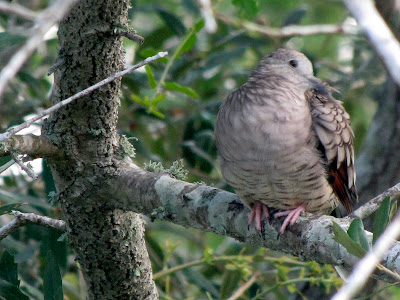A hot south wind ruffled the feathers of the Osprey that perched on the rail of our dock yesterday morning. The day started out hot and just got hotter, 106.9 degrees by mid afternoon.
Still, it was a lovely day for yard birding. Determined to get out there and find some birds despite the heat, I moved my lawn chair to the shade under a cedar elm and waited to see what would show up at the water drippers.
I was rewarded with a two-vireo, four-warbler day, not bad for the hottest day of the summer. This bright yellow beauty is a migrating Prothonotary Warbler. We also had a couple of Kentucky Warblers, several Black and White Warblers, and one or two Canada Warblers.
This Red-eyed Vireo is probably a migrant, too. I almost called it a Yellow-Green Vireo but the dark line at the edge of the gray cap made me say red-eyed though its eye didn't appear red. Yellow-Greens do nest in the Valley, but although this is a bright one, with quite a bit of yellow, I still think that dark edge on the cap is distinctive. I could be wrong.
I heard the White-eyed Vireo several times before this one came to the oak tree just above the bath. It could be a migrant, but I am pretty sure they nest in the area. I had one late in the spring and I have found small nests after breeding season that I am pretty sure are WEVI nests though I haven't seen any birds near them.
Butterflies are still a star attraction in the yard. Yesterday morning I took a photo of this Pipevine Swallowtail visiting a milkweed vine.
Still, it was a lovely day for yard birding. Determined to get out there and find some birds despite the heat, I moved my lawn chair to the shade under a cedar elm and waited to see what would show up at the water drippers.
I was rewarded with a two-vireo, four-warbler day, not bad for the hottest day of the summer. This bright yellow beauty is a migrating Prothonotary Warbler. We also had a couple of Kentucky Warblers, several Black and White Warblers, and one or two Canada Warblers.
This Red-eyed Vireo is probably a migrant, too. I almost called it a Yellow-Green Vireo but the dark line at the edge of the gray cap made me say red-eyed though its eye didn't appear red. Yellow-Greens do nest in the Valley, but although this is a bright one, with quite a bit of yellow, I still think that dark edge on the cap is distinctive. I could be wrong.
I heard the White-eyed Vireo several times before this one came to the oak tree just above the bath. It could be a migrant, but I am pretty sure they nest in the area. I had one late in the spring and I have found small nests after breeding season that I am pretty sure are WEVI nests though I haven't seen any birds near them.
Butterflies are still a star attraction in the yard. Yesterday morning I took a photo of this Pipevine Swallowtail visiting a milkweed vine.
Less than a minute after I took the photo above, a Couch's Kingbird alit on a wire overhead. I quickly focused my binocs on his prize. A closer look let me know what he was having for breakfast.
The yard is filled with drama, even early in the morning. Some of its inhabitants are not as lucky as others. I don't know why this kingbird is not repelled by the reported bitter taste of the butterfly, but if you click to enlarge the picture, you can see that it is indeed the swallowtail. I missed a picture of the capture by a few seconds--but the before-and-after photos tell the story.
A cool front this morning changed the wind from south to north and brought in relief from humidity. Today's temperature was a "cool" 95. It's still hot but our autumn birds seem to pay more attention to the calendar than the thermometer. Migration has indeed started.















